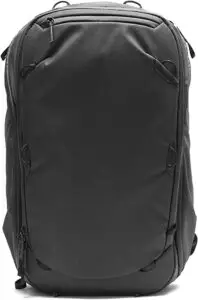When it comes to traveling, one of the most important decisions you’ll make is what to pack in your backpack. A well-packed backpack can make all the difference in a comfortable and enjoyable trip, while a poorly-packed one can leave you struggling with discomfort and inconvenience. The main backpack tips for traveling revolve around that: choosing the right backpack, and then packing it properly.
In this comprehensive guide, we’ll provide detailed information on how to pack your backpack for a journey, including useful tips and tricks for maximizing space and minimizing weight.
Choosing the Right Backpack
The first step in packing for a trip is choosing the right backpack. Not all backpacks are created equal, and different types of backpacks are designed for different types of travel. If you’re planning a long-distance hike, for example, you’ll need a backpack with a large capacity and durable construction. If you’re traveling by plane, on the other hand, you’ll want a backpack that meets carry-on size requirements and has a variety of pockets and compartments for organization.
TL;DR – Best Overall Backpack?
Peak Design Travel Line Backpack 45L

If you want some more in-depth information on choosing a backpack, consider the following:
Backpack capacity
How much space do you need to pack all of your belongings? A general rule of thumb is to aim for at least 50 liters of capacity for a week-long trip, but this can vary depending on your destination, the type of trip, and your personal packing style.
Comfort While Traveling
Will the backpack be comfortable to wear for long periods of time? Look for backpacks with padded straps and a ventilated back panel to help reduce sweat and discomfort. Adjustable straps are also a plus, as they allow you to customize the fit of your backpack to your body.
Durability
Is the backpack made of durable materials and well-constructed? Look for backpacks made of rugged and water-resistant materials such as nylon or polyester, and check for reinforced stress points and heavy-duty zippers.
Backpack Features
Does the backpack have pockets and compartments for organization? Multiple pockets and compartments can help keep your belongings organized and easily accessible. Look for features such as a separate compartment for your laptop or tablet, a hydration sleeve, and external attachment points for gear.
Types of Backpacks
There are several different types of backpacks to choose from, each with their own advantages and disadvantages. This is one of the hidden backpack tips for traveling that doesn’t get mentioned much – and once you know, you know. Here are a few examples of the types of backpacks you can encounter:
Internal frame backpack
These backpacks are designed for long-distance hiking and backpacking, with a sturdy frame that helps distribute the weight of your pack evenly across your body. They typically have a large capacity and are built to withstand rugged conditions.
External frame backpack
These backpacks have a frame on the outside of the pack, which can make it easier to load and unload gear. They are best for heavy loads and multi-day trips, but can be less comfortable for long-distance hiking.
Top-loading backpack
These backpacks have a single large compartment that you access from the top, similar to a duffel bag. They are great for packing large items such as sleeping bags, but can be less organized than other types of backpacks.
Panel-loading backpack
These backpacks have a large zipper on the front of the pack that opens to reveal a panel of compartments and pockets. They are easy to access and pack, making them great for everyday use and short trips.
Packing Your Backpack for Travel
Once you’ve chosen the right backpack, it’s time to start packing. To ensure that your backpack is packed efficiently and effectively, it’s important to follow a few basic principles:
Roll, don’t fold!
Rolling your clothes instead of folding them will save space and reduce wrinkles. Additionally, by rolling your clothes, you can also see all of the items you’ve packed and easily access them without having to dig through a pile of folded clothes.
Pack heavy items at the bottom
This will help to distribute the weight of your backpack evenly. By placing heavier items such as your shoes, water bottles, and camping gear at the bottom of your backpack, you’ll ensure that the weight is carried closer to your center of gravity and is less likely to cause strain on your shoulders and back.
Use compression bags
Compression bags can help to compress your clothes and other items, saving space in your backpack. These bags are designed to be vacuum-sealed, which will remove the air from inside and compress the contents, allowing you to pack more in the same space.
Use packing cubes
Packing cubes are a great way to organize your clothes and other items, making it easy to find what you need. These small, lightweight cubes are available in various sizes and can be used to separate clothes by type, such as t-shirts, pants, and underwear.
Packing Tips and Tricks
Here are a few additional tips and tricks to help you pack your backpack like a pro:
Utilize the space inside your shoes
Use plastic bags or compression bags to pack small items inside your shoes. This is a great way to save space and keep items such as socks, underwear, and toiletries organized.
Use a packing list
Make a list of everything you need to pack, and check it off as you go. This will help ensure that you don’t forget anything important and will also make it easier to repack your backpack after each day’s activities.
Wear your heaviest clothing
If you’re traveling in cold weather, wear your heaviest clothing on the plane to save space in your backpack. This will also help keep you warm during your flight.
Pack a small daypack
Pack a small daypack inside your larger backpack – a key backpack tip for travelling – as it’ll be crucial for day excursions where you want to leave your larger backpack in your hotel room. This will help keep your valuables safe while you’re out and about and will also make it easier to carry just the essentials for the day.
Conclusion
Packing a backpack for a trip can be a daunting task, but by following the tips and tricks outlined in this guide, you’ll be able to pack your backpack efficiently and effectively.
By choosing the right backpack, packing your backpack properly, and utilizing space-saving techniques, you’ll be able to travel with all the essentials and none of the unnecessary weight. Remember to consider the capacity, comfort, durability, and features of the backpack, and to always pack with a packing list.
Backpack Tips for Travelling: Related Questions!
What are the most important things to consider when choosing a backpack for travel?
Capacity, comfort, durability, and features are all important factors to consider when choosing a backpack for travel.
How can I save space when packing my backpack?
Rolling your clothes, using compression bags, and packing cubes are all effective ways to save space when packing your backpack. Additionally, utilizing the space inside your shoes and wearing your heaviest clothing can also save space.
How can I ensure that my backpack is comfortable to wear for long periods of time?
Choosing a backpack with padded straps and a ventilated back panel can help reduce sweat and discomfort.
Adjustable straps also allow you to customize the fit of your backpack to your body. Additionally, proper weight distribution and positioning of heavier items can also contribute to a comfortable wear.
What are the different types of backpacks?
Internal frame, external frame, top-loading and panel-loading backpacks are some examples of different types of backpacks
What are the best materials for a backpack?
Nylon and polyester are popular materials for backpacks as they are durable, water-resistant, and lightweight. Canvas and leather are also good options, but they tend to be heavier and less water-resistant.
How can I pack my backpack for a multi-day hike?
When packing for a multi-day hike, it’s important to prioritize essentials such as water, food, shelter, and clothing. Additionally, pack your backpack with the heavier items closer to your back and lower in the pack, and use compression bags to save space. Bring a waterproof cover for your backpack to protect your belongings in case of rain or inclement weather.
Should I bring a separate daypack or just use my main backpack?
It depends on your preference and the type of trip you are going on. Having a separate daypack can be useful for day excursions, keeping your valuables safe while leaving your larger backpack in a hotel room or campsite. However, if you prefer to keep everything in one backpack and don’t mind carrying the weight, then you may not need a separate daypack.
How can I keep my backpack organized while travelling?
Backpack tips for traveling include using packing cubes, compression bags and packing list can help keep your backpack organized. Additionally, keep your valuables in a small daypack or an internal compartment of your backpack to easily access them and keep them secure.
How do I properly clean my backpack?
It depends on the material of the backpack. For nylon and polyester backpacks, you can use mild soap and warm water to clean the exterior and interior. Avoid using harsh chemicals or bleach. For canvas and leather backpacks, use a damp cloth and mild soap to clean, and apply a waterproofing spray to protect the material. Be sure to follow the manufacturer’s care instructions for specific cleaning instructions.

